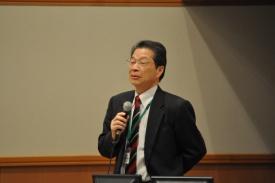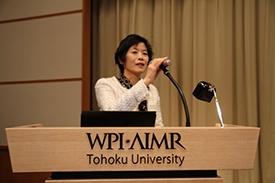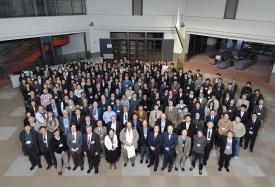

03/26/2012
The WPI-AIMR Annual Workshop is a focal point of the intellectual life of the WPI-AIMR, and brings together members of the institute from across the world to discuss the latest developments in materials science and the work of the WPI-AIMR.
The 5th Annual Workshop, the first since the Great East Japan Earthquake that struck the region on 11 March 2011, causing widespread damage and loss of life, was held at the Sendai International Center from 20–24 February under the theme of “Cutting-edge Functional Materials for Green Innovation” and attracted 267 participants from 10 countries. As the research institution closest to the epicenter of the Great East Japan Earthquake, Tohoku University sustained heavy damage to much of its equipment. However, the university was able to resume most of its pre-earthquake activities in less than half a year due to the committed efforts of staff and students, supported by central government and municipal authorities and the determination of the local community to overcome the disaster. As part of the national effort of reconstruction and regeneration, a new International Research Institute of Disaster Science will be opened in 2012 at Tohoku University.

The 2012 Annual Workshop was also the first to be held since the opening of the Mathematics Unit as the fifth research group of the WPI-AIMR in March 2011, and the interaction between mathematics and materials science was given a central place in the workshop's program. The key role that mathematics is intended to play in the scientific direction of the WPI-AIMR in the next five years was mentioned by the current WPI director, Yoshinori Yamamoto in his welcoming address to delegates on the first full day of the workshop. “We strongly expect mathematics to accelerate ‘fusion’ and interdisciplinary research between the four existing research groups,” said Yamamoto. “This is because mathematics is able to address fundamental issues from a wide range of research areas … we believe that interdisciplinary and fusion research catalyzed by mathematics will lead to an entirely new kind of materials science,” he added.
Yamamoto, who has led the WPI-AIMR since its opening in 2007, will step down as director in April 2012 to be succeeded by Motoko Kotani, an internationally recognized mathematician and winner of the Saruhashi Prize, given to outstanding Japanese women scientists, which she received in 2005 for her work on Discrete Geometric Analysis of Crystal Lattices. Kotani is the current deputy director of the WPI-AIMR and head of the Mathematics Unit, and will become the first female director of a WPI center when she leads the WPI-AIMR from April 2012.

The theme of mathematics-guided materials science research was also emphasized by Akihisa Inoue, the president of Tohoku University, in his opening speech to the assembled delegates. Inoue began by praising the work of the WPI-AIMR, which, since its establishment, had “made tremendous efforts to advance research activities that fuse fields and create new disciplines while reforming and educating its research environment.” Inoue also welcomed the challenges and opportunities offered by the “new mathematical viewpoint” which he foresaw promoting “interdisciplinary and fusion research which will create a new materials science as well as developing innovative functional materials” and making a major contribution to the continuing development of the WPI-AIMR as a “unique and leading hub of the materials sciences in the world.” The enhanced international character of the WPI-AIMR also won praise from the university president, who noted that 61 of the 127 researchers at the institute are non-Japanese nationals, and commended the role played by the 15 WPI-AIMR overseas partners and the three satellite institutions at the University of Cambridge; the University of California, Santa Barbara and the Institute of Chemistry at the Chinese Academy of Sciences.
Inoue also discussed the key role of the WPI-AIMR at Tohoku University, and noted that through the Tohoku University Action Plan (the Inoue Plan) the university promises to strengthen the organization of the WPI-AIMR to aid its development as an international research network. Furthermore he indicated that the university intends to extend its “maximum and continuing support” to the center after the completion of the WPI program to “establish an advanced institute of materials science as a world-leading center of intellect based on the achievements of WPI-AIMR.”

The new focus on mathematics-guided materials science at the WPI-AIMR was also reflected in the academic program of the workshop, which began with a Mathematics–Materials plenary session chaired by Kotani and featured lectures on quantum mechanics, the theory of aperiodic solids and network formation and ion conduction in ionomer membranes. These were followed on the first day by sessions on bulk metallic glasses, materials physics and soft materials and over the course of the workshop by sessions covering other key aspects of the work of the WPI-AIMR, including systems and devices, soft materials, biodevices and materials chemistry. In total 39 lectures divided into 13 plenary and parallel sessions were presented during the three-day workshop, as well as a two-day poster session, which drew close to 90 contributions from WPI-AIMR researchers in Japan and overseas on a wide range of cutting-edge materials science research.
The 5th WPI-AIMR Annual Workshop was concluded on 24 February with a closing address from the director-in-waiting, Motoko Kotani. In this address, Kotani spoke of her vision of the WPI-AIMR as an institute driven by bottom-up fusion research guided by a mathematical understanding of the fundamental aspects of materials science, and indicated a number of areas as key topics for study, including non-equilibrium materials based on mathematical dynamical systems, topological functional materials, and multi-scale hierarchical materials based on discrete geometric analysis. Kotani ended her address by thanking the organizers, speakers and participants before inviting all present to join the next WPI-AIMR Annual Workshop to be held on 18–23 February 2013.